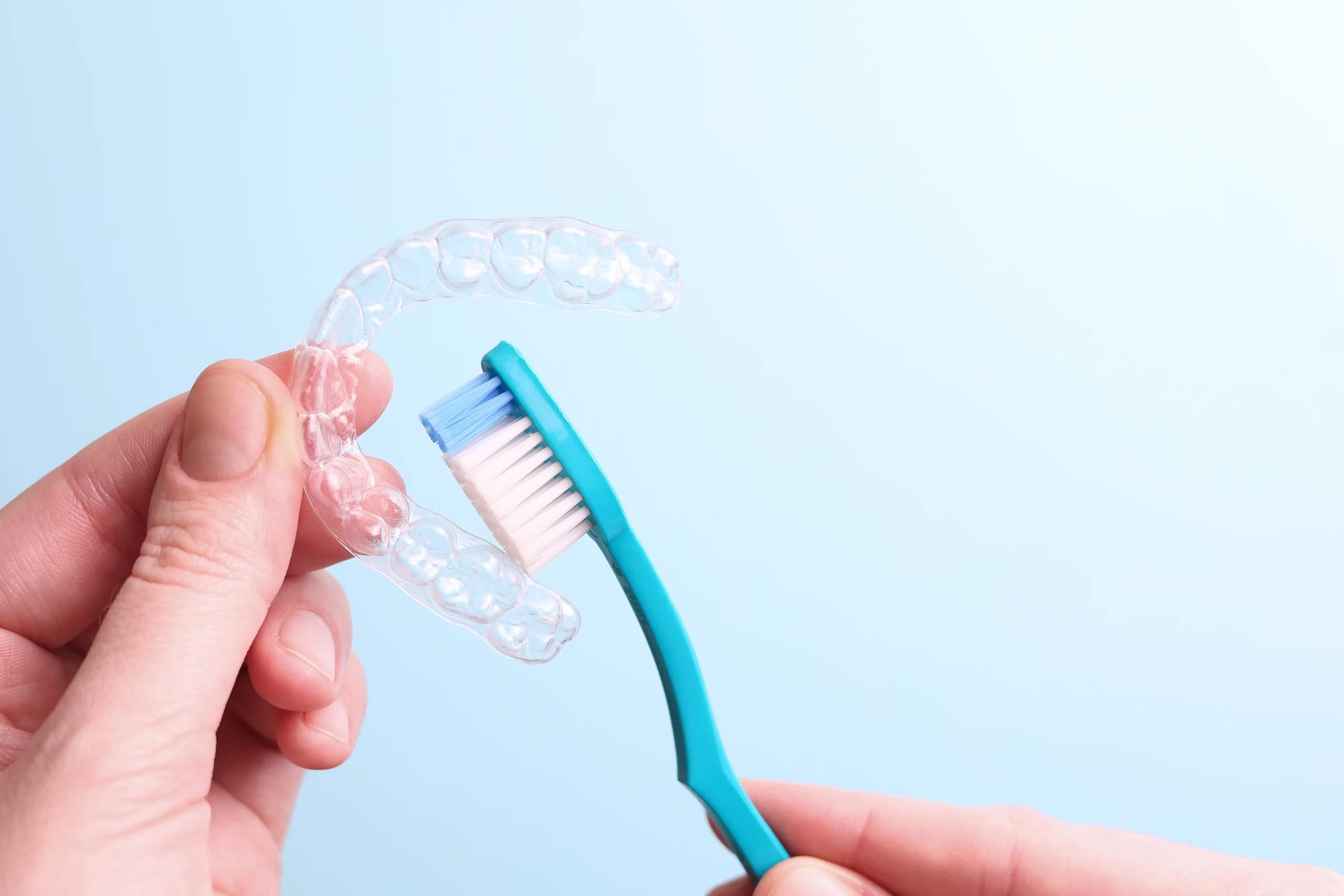Why Cleaning Your Invisalign Matters
Your aligners sit tightly against your teeth for most of the day, typically 20 to 22 hours, creating a warm and moist environment that can quickly collect plaque and bacteria. If you don’t clean your Invisalign properly, it can lead to bad breath, cloudy or stained aligners, and even gum irritation. Clean aligners not only look better but also protect your oral health throughout treatment.
Daily Routine to Clean Invisalign Trays
The foundation of good aligner hygiene is a daily routine. To clean Invisalign trays effectively, rinse them immediately after removal, before eating, drinking, or brushing your teeth. Use lukewarm (never hot) water to avoid warping the plastic. After rinsing, gently brush them using a soft toothbrush that’s separate from your regular toothbrush. Avoid toothpaste, as it can be abrasive and cause scratches that trap bacteria.
When brushing, use small circular motions on both the inside and outside of each aligner. Rinse thoroughly before putting them back in your mouth. If you follow this simple process twice daily, your aligners will stay clear and odor-free.
Deep Cleaning with Invisalign Cleaning Crystals
Sometimes brushing alone isn’t enough to keep your aligners perfectly clean, especially if you notice buildup or cloudiness. That’s when cleaning crystals come in handy. These specialized crystals are designed by Invisalign to remove plaque and bacteria without damaging the aligners.
To use them, fill a cup with lukewarm water and dissolve the crystals according to the package instructions. Soak your aligners for about 15 to 20 minutes, then brush and rinse them thoroughly before wearing them again. Using this method two to three times a week helps maintain optimal hygiene and keeps your aligners looking like new.
Using Baking Soda as a Natural Cleaning Option
If you prefer a simple, inexpensive home remedy, baking soda is an excellent choice for cleaning Invisalign aligners. It’s gentle, non-toxic, and effective at removing stains and odors. Mix one tablespoon of baking soda with a cup of lukewarm water, then soak your aligners for about 30 minutes. After soaking, rinse them thoroughly and gently brush them before returning them to their original position.
The Role of Antibacterial Soap in Aligner Care
For a quick and easy cleaning option, antibacterial soap can be used as part of your aligner care routine. Choose a clear, mild, unscented liquid soap and mix a small amount with lukewarm water. Use a soft toothbrush to gently scrub your aligners, rinse thoroughly, and allow them to air dry.
The Best Cleaning Methods for Invisalign Aligners
There are several cleaning methods to choose from, depending on your needs and preferences. Here is the summary of the most effective ones:
1. Brushing and Rinsing
The most basic and essential method involves brushing and rinsing with lukewarm water. This should be done multiple times a day, especially before reinserting your aligners after meals.
2. Soaking in Cleaning Crystals
Ideal for removing deeper buildup, Invisalign cleaning crystals are a safe and effective way to disinfect your aligners.
3. Using Baking Soda Solutions
A natural and affordable option, baking soda helps keep aligners odor-free and bright.
4. Antibacterial Soap Cleaning
An easy method for quick cleanings when you’re at home or traveling.
Regardless of the method you choose, consistency is key. Cleaning your aligners daily helps prevent odor and discoloration while maintaining the health of your mouth.
Common Cleaning Products You Can Use Safely
When it comes to cleaning products, it’s important to choose items that are safe for the delicate plastic material of Invisalign aligners. Safe options include Invisalign cleaning crystals, mild antibacterial soaps, and baking soda solutions. Always steer clear of harsh chemicals, denture cleaners, or toothpaste with abrasive ingredients.
Mistakes to Avoid When You Clean Your Invisalign
Even with good intentions, some cleaning habits can damage your aligners or make them less effective. Avoid these common mistakes to keep your treatment on track:
Using Hot Water
Hot water can cause the thermoplastic material to warp, resulting in an improper fit of your aligners. Always use cool or lukewarm water.
Skipping Daily Cleaning
Even missing one day can lead to buildup and foul odors. Make cleaning part of your morning and nighttime routines.
Using Toothpaste or Harsh Scrubs
Toothpaste can scratch the aligners, making them look cloudy. Stick to gentle, non-abrasive cleaning methods instead.
Forgetting to Brush Before Reinserting
If you put aligners back in without brushing your teeth first, you can trap food particles and bacteria against your enamel.
Using Scented Soaps or Colored Cleaners
These can stain or leave residue on your aligners, which can affect their transparency and taste.
Why You Should Avoid Mouthwashes
It may be tempting to soak your aligners in mouthwash, but it’s best to avoid mouthwash altogether for cleaning purposes. Most mouthwashes contain alcohol or colored dyes that can damage and discolor your aligners. The alcohol can dry out the plastic, making it more brittle over time.
Additional Tips to Keep Invisalign Clean and Clear
Along with regular cleaning, there are a few habits that can help you maintain the clarity and quality of your aligners throughout treatment:
Always store them properly. Use the provided case whenever you remove your aligners to protect them from bacteria and dirt.
Rinse before reinserting. Even if you haven’t eaten, a quick rinse removes saliva and prevents bacterial buildup.
Brush and floss after meals. Clean teeth mean clean aligners, reducing the risk of odor and plaque.
Replace aligners as directed. Since you switch to a new set every couple of weeks, following your schedule ensures your treatment stays on track and your aligners remain clean and effective.
Maintaining a Consistent Cleaning Routine
Consistency is the key to keeping your aligners in great shape. Incorporate cleaning into your daily habits, just like brushing and flossing. By following proper cleaning methods and using safe cleaning products, you can protect both your Invisalign trays and your oral health.
A few minutes a day can make a big difference in keeping your aligners clear, comfortable, and odor-free throughout your treatment journey.
Final Thoughts on Cleaning Invisalign Aligners
Keeping your aligners clean is an essential part of successful Invisalign treatment. These clear plastic trays work best when they’re free from buildup and bacteria, which is why a consistent oral hygiene routine is so important. Regular brushing with a soft-bristled toothbrush and rinsing with warm water helps prevent dirty aligners that can lead to bad breath and even tooth decay.
For deeper cleaning, you can let your aligners soak in a safe cleaning solution, such as Invisalign crystals, hydrogen peroxide, or a mixture containing sodium carbonate, to remove residue and keep them crystal clear. Another effective option is to use clear antibacterial soap for a quick daily cleanse.
Compared to metal braces, which can trap food and make cleaning more difficult, Invisalign offers a much simpler way to maintain oral health while straightening crooked teeth. By taking the time to properly clean and care for your aligners each day, you’ll protect your teeth, extend the life of your trays, and keep your smile bright throughout your Invisalign journey.

About the Author
Dr Meghan Wilhelmi
MDM
Dr. Meghan is originally from North Reading, MA, and earned her Biology degree from UMass Amherst before completing her DMD at Tufts University. She went on to finish her pediatric dental residency in Maryland through NYU Lutheran.



